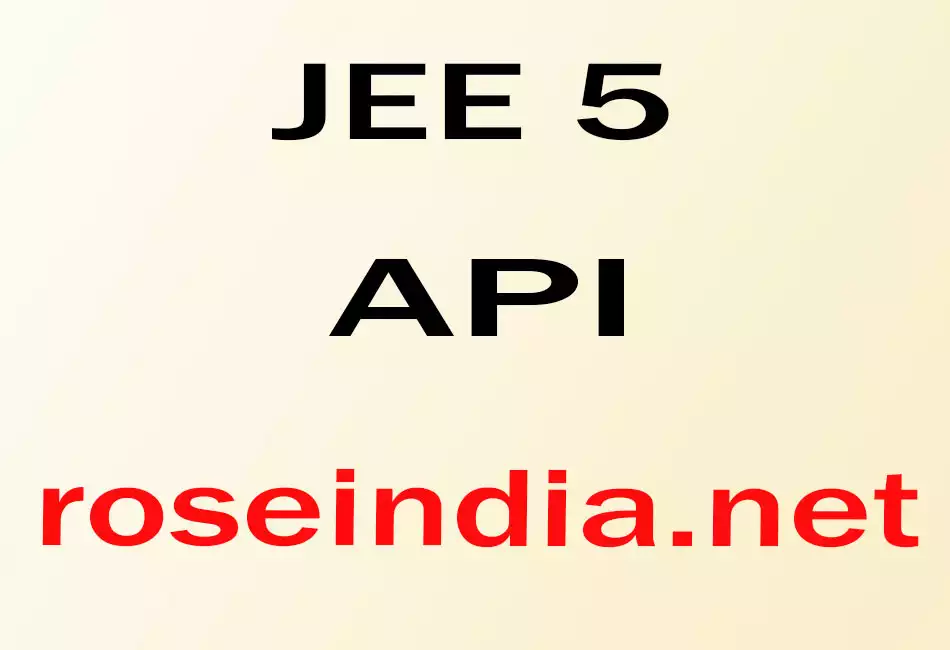The list presented here will list the APIs available on the Java EE 5 platform.

JEE 5 API
The list presented here will list the APIs available on the Java EE 5 platform.
| API | Description |
| Java EE 5 | The main focus of Java Platform, Enterprise Edition 5 (Java EE 5) is to make the development easier. |
| Web Services Technologies | |
| Implementing Enterprise Web Services | This specification defines the programming model and runtime architecture for developing web services using Java technologies. |
| Java API for XML-Based Web Services (JAX-WS) 2.0 | The Java API for XML Web Services or JAX-WS for short, is the centerpiece of a newly rearchitected API stack for Web services. It includes includes JAX-WS 2.0, JAXB 2.0, and SAAJ 1.3. |
| Java API for XML-Based RPC (JAX-RPC) 1.1 | Java API for XML-based RPC or JAX-RPC for short to can be used to build Web applications and Web services, incorporating XML-based RPC functionality according to the SOAP 1.1 specification. |
| Java Architecture for XML Binding (JAXB) 2.0 | Java Architecture for XML Binding (JAXB) provides a convenient way to bind an XML schema to a representation in Java code. |
| SOAP with Attachments API for Java (SAAJ) | The SOAP with Attachments API for Java (SAAJ) provides a standard way to send XML documents over the Internet from the Java platform. |
| Streaming API for XML | StAX provides is the latest API in the JAXP family, and provides an alternative to SAX, DOM, TrAX, and DOM for developers looking to do high-performance stream filtering, processing, and modification, particularly with low memory and limited extensibility requirements. |
| Web Service Metadata for the Java Platform | This JSR defines an annotated JavaTM format that that uses JavaTM Language Metadata (JSR 175) to enable easy definition of Java Web Services in a J2EE container. |
| Component Model Technologies | |
| Enterprise JavaBeans 3.0 | Enterprise JavaBeans (EJB) technology is the server-side component architecture for Java Platform, Enterprise Edition (Java EE). EJB technology enables rapid and simplified development of distributed, transactional, secure and portable applications based on Java technology. |
| J2EE Connector Architecture 1.5 | The J2EE Connector architecture provides a Java technology solution to the problem of connectivity between the many application servers and today's enterprise information systems (EIS). |
| Java Servlet 2.5 | Java Servlet technology provides Web developers with a simple, consistent mechanism for extending the functionality of a Web server and for accessing existing business systems |
| JavaServer Faces 1.2 | JavaServer Faces technology simplifies building user interfaces for JavaServer applications. |
| JavaServer Pages 2.1 | JavaServer Pages (JSP) technology provides a simplified, fast way to create dynamic web content. JSP |
| JavaServer Pages Standard Tag Library 1.2 | The JavaServer Pages Standard Tag Library (JSTL) encapsulates as simple tags the core functionality common to many Web applications. JSTL has support for common, structural tasks such as iteration and conditionals, tags for manipulating XML documents, internationalization tags, and SQL tags. It also provides a framework for integrating existing custom tags with JSTL tags. |
| Management Technologies | |
| J2EE Management | The Java Platform, Enterprise Edition (J2EE) Management Specification defines the J2EE Management Model, which is designed to be interoperable with many management systems and protocols. |
| J2EE Application Deployment | It defines standard APIs to enable deployment of components and applications based on the J2EE platform, as well as the development of platform-independent deployment tools. |
| Java Authorization Contract for Containers | The Java Authorization Contract for Containers (Java ACC) specification (JSR-115) defines new java.security.Permission classes to satisfy the Java 2 Platform, Enterprise Edition (J2EE) authorization model. The Java ACC specification defines the binding of container access decisions to operations on instances of these permission classes. |
| Other Java EE Technologies | |
| Common Annotations for the Java Platform | This JSR will develop annotations for common semantic concepts in the J2SE and J2EE platforms that apply across a variety of individual technologies. |
| Java Transaction API (JTA) | JTA specifies standard Java interfaces between a transaction manager and the parties involved in a distributed transaction system: the resource manager, the application server, and the transactional applications. |
| JavaBeans Activation Framework (JAF) 1.1 | With the JavaBeans Activation Framework standard extension, developers who use Java technology can take advantage of standard services to determine the type of an arbitrary piece of data, encapsulate access to it, discover the operations available on it, and to instantiate the appropriate bean to perform said operation(s). |
| JavaMail | The JavaMail API provides a platform-independent and protocol-independent framework to build mail and messaging applications. |
| Java Message Service API | The Java Message Service (JMS) API is a messaging standard that allows application components based on the Java 2 Platform, Enterprise Edition (J2EE) to create, send, receive, and read messages. It enables distributed communication that is loosely coupled, reliable, and asynchronous. |
| Java Persistence API | The Java Persistence API draws upon the best ideas from persistence technologies such as Hibernate, TopLink, and JDO. Customers now no longer face the choice between incompatible non-standard persistence models for object/relational mapping. In addition, the Java Persistence API is usable both within Java SE environments as well as within Java EE, allowing many more developers to take advantage of a standard persistence API. |



